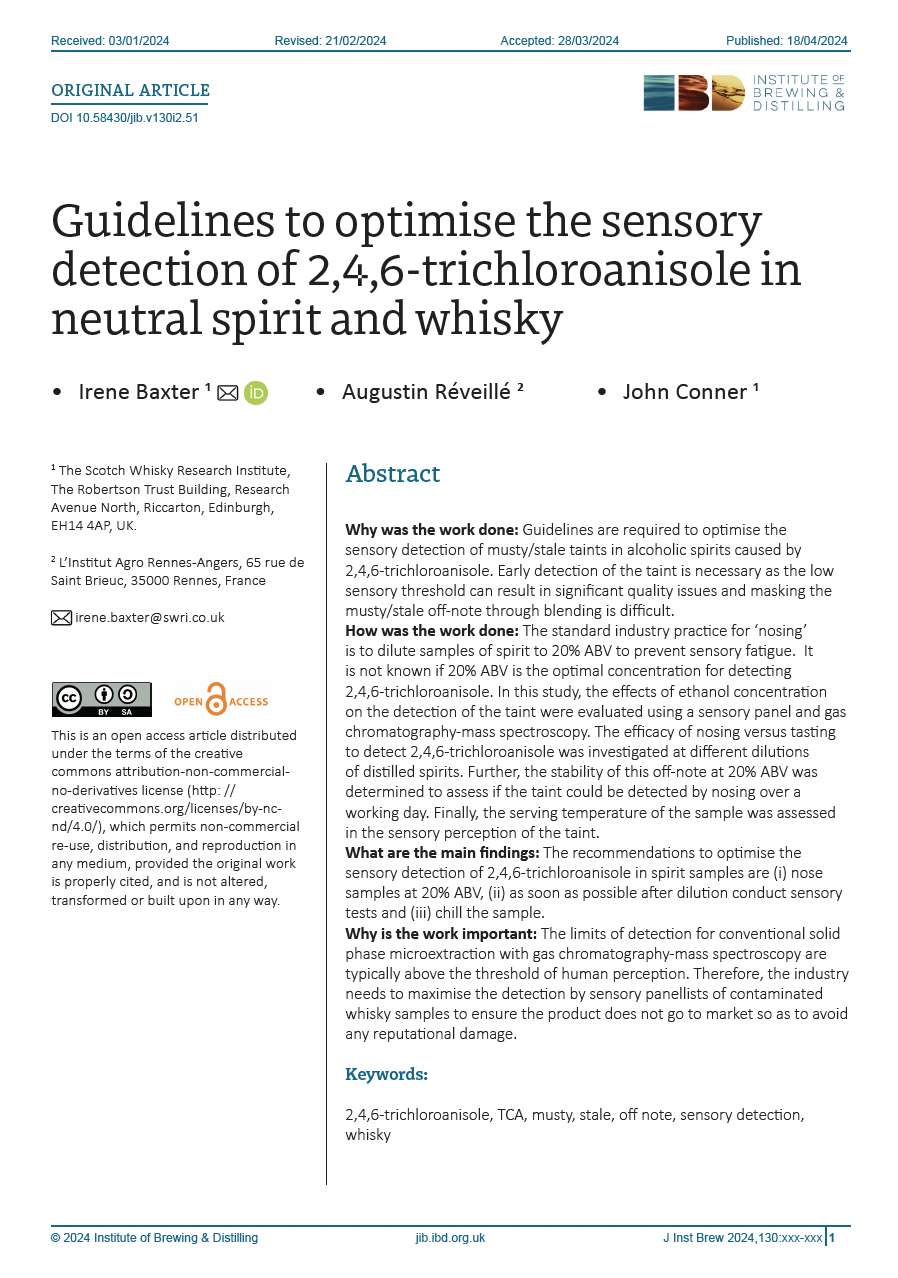Guidelines to optimise the sensory detection of 2,4,6-trichloroanisole in neutral spirit and whisky
DOI:
https://doi.org/10.58430/jib.v130i2.51Keywords:
2,4,6-trichloroanisole, TCA, musty, stale, off note, sensory detection, whiskyAbstract
Why was the work done: Guidelines are required to optimise the sensory detection of musty/stale taints in alcoholic spirits caused by 2,4,6-trichloroanisole. Early detection of the taint is necessary as the low sensory threshold can result in significant quality issues and masking the musty/stale off-note through blending is difficult.
How was the work done: The standard industry practice for ‘nosing’ is to dilute samples of spirit to 20% ABV to prevent sensory fatigue. It is not known if 20% ABV is the optimal concentration for detecting 2,4,6-trichloroanisole. In this study, the effects of ethanol concentration on the detection of the taint were evaluated using a sensory panel and gas chromatography-mass spectroscopy. The efficacy of nosing versus tasting to detect 2,4,6-trichloroanisole was investigated at different dilutions of distilled spirits. Further, the stability of this off-note at 20% ABV was determined to assess if the taint could be detected by nosing over a working day. Finally, the serving temperature of the sample was assessed in the sensory perception of the taint.
What are the main findings: The recommendations to optimise the sensory detection of 2,4,6-trichloroanisole in spirit samples are (i) nose samples at 20% ABV, (ii) as soon as possible after dilution conduct sensory tests and (iii) chill the sample.
Why is the work important: The limits of detection for conventional solid phase microextraction with gas chromatography-mass spectroscopy are typically above the threshold of human perception. Therefore, the industry needs to maximise the detection by sensory panellists of contaminated whisky samples to ensure the product does not go to market so as to avoid any reputational damage.
Downloads
References
Agilent. Headspace sampling fundamentals. What is headspace? https://www.agilent.com/en/product/gas-chromatography/gc-sample-preparation-introduction/what-is-headspace
Chatonnet P, Bonnet S, Boutou S, Labadie M-D. 2004. Identification and responsibility of 2,4,6-tribromoanisole in musty, corked odors in wine. J Agric Food Chem 52:1255-1262.
Chatonnet P, Fleury A, Boutou S. 2010. Identification of a new source of contamination of Quercus sp. Oak wood by 2,4,6-trichloroanisole and its impact on the contamination of barrel-aged wines. J Agric Food Chem 58:10528-10538.
Conner JM, Paterson A, Piggott JR. 1994. Agglomeration of ethyl esters in model spirit solutions and malt whiskies. J Sci Food Agric 66:45-53.
Conner J, Birkmyre L, Paterson A, Piggott J. 1998. Headspace concentrations of ethyl esters at different alcoholic strengths. J Sci Food Agric 77:121-126.
Cravero MC. 2020. Musty and moldy taints in wine: a review. Beverages 6(2):41
Cravero MC, Bonello F, Alvarez MDCP, Tsolakis C, Borsa D. 2015. The sensory evaluation of 2,4,6-trichloroanisole in wines. J Inst Brew 121:411–417.
Field J, Sierra-Alvarez R. 2008. Microbial degradation of chlorinated phenols. Rev Environ Sci Biotechnol 7:211-241.
Ickes CM, Cadwallader KR. 2017. Effects of ethanol on flavor perception in alcoholic beverages. Chem Percept 10:119–134.
Ickes CM, Cadwallader KR. 2018. Effect of ethanol on flavor perception of rum. Food Sci Nutr 6:912-924.
ISO 13299:2016. Sensory analysis – methodology – general guidance for the establishment of a sensory panel. https://www.iso.org/
Jack FR. 2003. Development of guidelines for the preparation and handling of sensory samples in the Scotch whisky industry. J Inst Brew 109:114-119.
Karlsson BCG, Friedman R. 2017. Dilution of whisky – the molecular perspective. Scientific Reports 7:6489.
MacGarry, S. 2023. The effects of ethanol on the flavour of whisky. MRes thesis, Edinburgh Napier University.
Mazzoleni V, Maggi L. 2007. Effect of wine stye on the perception of 2,4,6-trichloroanisole, a compound related to cork taint in wine. Food Res Int 40:694-699.
Simpson RF, Sefton MA. 2007. Origin and fate of 2,4,6-trichloroanisole in cork bark and wine corks. Aust J Grape Wine Res 13:106-116.
Takeuchi H, Kato H, Kurahashi T. 2013. 2,4,6-trichloroanisole is a potent suppressor of olfactory signal transduction. Proc Natl Acad Sci USA 110:16235-16240.
Tarasov A, Cabral M, Loisel C, Lopes P, Schuessler C, Jung R. 2022. State-of-the-art knowledge about 2,4,6-trichloroanisole (TCA) and strategies to avoid cork taint in wine. In Morata A, Loira I, Gonzalez C (eds) Grapes and Wine. IntechOpen.
Tempere S, Schaaper MH, Cuzange E, de Revel G, Sicard G. 2017. Masking of several olfactory notes by infra-threshold concentrations of 2,4,6-trichloroanisole. Chem Percept 10:69–80.
Zhang K, Luo Z, Tuqiao T, Mao M, Fu J. 2016. Study on formation of 2,4,6-trichloroanisole by microbial O-methylation of 2,4,6-trichlorophenol in lake water. Environ Pollut 219:228-234.

Downloads
Published
Versions
- 03-05-2024 (2)
- 18-04-2024 (1)
How to Cite
Issue
Section
License
Copyright (c) 2024 Journal of the Institute of Brewing

This work is licensed under a Creative Commons Attribution-NonCommercial-NoDerivatives 4.0 International License.
This is an open access article which permits non-commercial re-use, distribution, and reproduction in any medium, provided the original work is properly cited, and is not altered, transformed or built upon in any way.
Permission will be required if the proposed reuse is not covered by the terms of the License. In this event, email the Editor in Chief - david.quain@ibd.org.uk - with details of your request.





